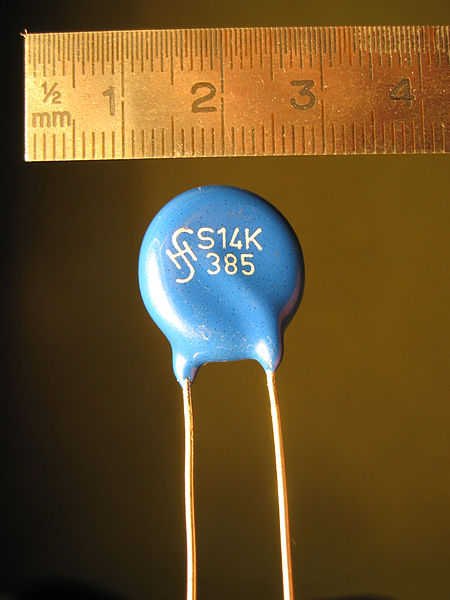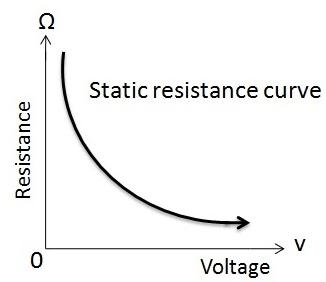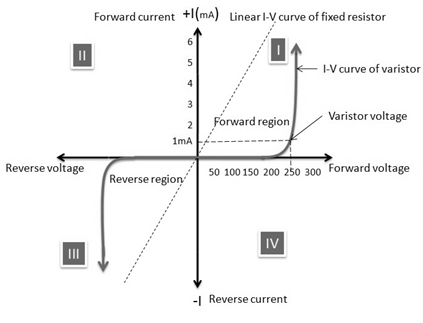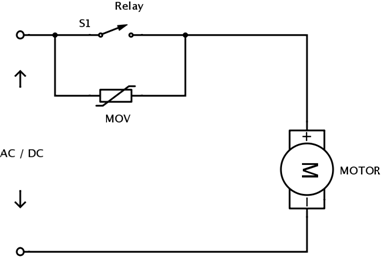A varistor is an electronic component with an electrical resistance that varies with the applied voltage. Also known as a voltage-dependent resistor (VDR), it has a nonlinear, non-ohmic current–voltage characteristic that is similar to that of a diode.
Catalog
Ⅰ What is a varistor ?
varistors were indeed constructed by connecting two rectifiers, such as the copper-oxide or germanium-oxide rectifier in antiparallel configuration. At low voltage the varistor has a high electrical resistance which decreases as the voltage is raised. Modern varistors are primarily based on sintered ceramic metal-oxide materials which exhibit directional behavior only on a microscopic scale. This type is commonly known as the metal-oxide varistor (MOV).

Varistors
Varistors are used as control or compensation elements in circuits either to provide optimal operating conditions or to protect against excessive transient voltages. When used as protection devices, they shunt the current created by the excessive voltage away from sensitive components when triggered.
The name varistor is a portmanteau of varying resistor. The term is only used for non-ohmic varying resistors. Variable resistors, such as the potentiometer and the rheostat, have ohmic characteristics.
Ⅱ How do varistors work?
A varistor does not obey Ohm’s law and hence it is not like an ohmic resistor. It is basically a non-ohmic resistor that does not follow Ohm’s law and hence it is also called a non-linear resistor or a voltage-dependent resistor. The basic difference between a normal resistor and a voltage-dependent resistor is that would the resistance of a resistor can be altered only by manual action but we can alter the resistance by altering the voltage. The working principle of this is similar to that of a PN junction diode during reverse bias operation.
Ⅲ What are the working and characteristics of varistor?
In a normal situation, this does not conduct any current. But when the applied voltage crosses the reverse breakdown voltage, the diode starts to conduct electric current.
Under normal conditions, a barrister has a very high voltage. However, when the transient voltage in the circuit starts to increase, then the resistance of this will start to decrease so that the transient voltage remains fixed at a certain level.
The Resistance of a Varistor
The working of a varistor can be explained using the resistance graph. It is a graph drawn between the resistance of the resistor and the applied voltage. The graph indicates that during normal conditions, the resistance is very high. However, if the applied voltage exceeds the rated value of the resistor, then the resistance of this will start to decrease.

resistance-of-varistor
Ⅳ Characteristics of V-I
From the V-I characteristics graph, we can see that even a small change in the amount of applied voltage can lead to a huge change in the amount of current in the circuit. In the V-I characteristics graph, we can see that the varistor acts as if two Zener diodes have been connected back to back. The voltage level at which the current starts to flow is 1mA.
During this state, the varistor changes from an insulator to a conductor. This occurs because of the fact that the applied voltage becomes greater than or equal to the rated voltage of the device. This leads to the Avalanche effect of the semiconductor material thus turning a varistor from an insulator to a conductor.

v-i-characteristics
Ⅴ Metal oxide varistor
The most common modern type of varistor is the metal-oxide varistor (MOV). This type contains a ceramic mass of zinc oxide grains, in a matrix of other metal oxides, such as small amounts of bismuth, cobalt, manganese oxides, sandwiched between two metal plates, which constitute the electrodes of the device. The boundary between each grain and a neighbor forms a diode junction, which allows current to flow in only one direction. The accumulation of randomly oriented grains is electrically equivalent to a network of back-to-back diode pairs, each pair in parallel with many other pairs.
When a small voltage is applied across the electrodes, only a tiny current flows, caused by reverse leakage through the diode junctions. When a large voltage is applied, the diode junction breaks down due to a combination of thermionic emission and electron tunneling, resulting in a large current flow. The result of this behavior is a nonlinear current-voltage characteristic, in which the MOV has a high resistance at low voltages and a low resistance at high voltages.
Ⅵ Characteristics of a damaged varistor
While a MOV is designed to conduct significant power for very short durations (about 8 to 20 microseconds), such as caused by lightning strikes, it typically does not have the capacity to conduct sustained energy. Under normal utility voltage conditions, this is not a problem. However, certain types of faults on the utility power grid can result in sustained over-voltage conditions. Examples include a loss of a neutral conductor or shorted lines on the high voltage system. Application of sustained over-voltage to a MOV can cause high dissipation, potentially resulting in the MOV device catching fire. The National Fire Protection Association (NFPA) has documented many cases of catastrophic fires that have been caused by MOV devices in surge suppressors, and has issued bulletins on the issue.
A 130 volt, 150 J MOV that has undergone catastrophic failure, apparently as a result of a lightning strike, showing evidence of heat and smoke. The 3 amp fast-blow fuse immediately in front of the varistor blew during the same event.
A series connected thermal fuse is one solution to catastrophic MOV failure. Varistors with internal thermal protection are also available.
There are several issues to be noted regarding behavior of transient voltage surge suppressors (TVSS) incorporating MOVs under over-voltage conditions. Depending on the level of conducted current, dissipated heat may be insufficient to cause failure, but may degrade the MOV device and reduce its life expectancy. If excessive current is conducted by a MOV, it may fail catastrophically, keeping the load connected, but now without any surge protection. A user may have no indication when the surge suppressor has failed. Under the right conditions of over-voltage and line impedance, it may be possible to cause the MOV to burst into flames, the root cause of many fires and the main reason for NFPA's concern resulting in UL1449 in 1986 and subsequent revisions in 1998 and 2009. Properly designed TVSS devices must not fail catastrophically, resulting in the opening of a thermal fuse or something equivalent that only disconnects MOV devices.
Ⅶ How to test varistors?
The applications are
1). These can be used to protect electrical circuits from excessively high voltage. The following circuit shows how a metal oxide type can be connected to a circuit to protect it from high voltage.

metal-oxide
2). The devices connected in an electronic circuit are extremely sensitive to change in voltage. So we use this component in the circuit to protect the different components of the electric circuit. Here, we can see how this can be used to protect a transistor in the circuit.

varistor-to-protect-transistor
3). It can also be used to provide surge protection in AC and DC motors.

varistor-in-ac-dc-motors
Advantages
The advantages of Varistors are
It can be used to protect the electric components of an electric circuit.
It provides surge protection to the AC and DC motors.
Disadvantages
The disadvantages of Varistors are
It cannot provide protection from current during a short circuit.
It cannot provide protection from current surges during the startup of the device.
It cannot provide protection from voltage sags.
FAQs
1). Does a varistor have polarity?
In the case of metal oxide varistor, a zinc-oxide layer is basically sandwiched between two metal electrodes. As a result, there is no polarity.
2). What happens when a varistor fails?
This may fail due to two reasons: degradation and catastrophic failure. Catastrophic failure mainly occurs when we do not limit a large surge and the magnitude of the energy is higher than the value which the capacitor can handle. As a result of a failure, non-uniform joule heating may occur in the circuit.
3). What is the varistor voltage?
The voltage generated across the terminals of a varistor when a current of 1mA is allowed to pass through it is called varistor voltage. It is basically the voltage rating.
4). How do you test a metal oxide varistor?
A metal-oxide type can be tested using a multimeter. One probe of this should touche the free varistor lead and the other probe should touch the connected lead.
5). What is the difference between varistor and thermistor?
A varistor is an electric element that has a variable resistance and which can protect an electric circuit against power surges. A thermistor, on the other hand, is a resistor whose resistance varies according to the change in temperature.
Please refer to this link to know more about Surge Protector.
Thus, this is all about an overview of varistor that can serve as a very important device in an electric circuit. Its main use is that it can be used in the protection of electric circuits. It has various other uses as well. How do you think a varistor can be used in real-life projects?
Filed Under: BasicsTagged With: Resistor, Voltage Sensor.




 Need Help?
Need Help?







